T.F. Green Airport Combines Science & Nature for Green Deicing Treatment

As manager of environmental programs for the authority that operates T.F. Green Airport (PVD), Jay Brolin is intimately familiar with all things, well, "green." Broadly versed in a wide variety of sustainability methods, his vast knowledge base recently expanded to include a thorough understanding of-and unique alliance
with-bugs.
But the bugs that captivate Brolin's attention aren't the pesky insects that fly or crawl around the Rhode Island airport or splat on the windshields of tenants' aircraft. Instead, they are prolific anaerobic bacteria that have proved to be a game-changer for PVD's deicing treatment system. (They're also the same kind of bugs that treat wastewater from breweries such as Anheuser-Busch and foodmakers such as Smuckers.)
Microscopic Workhorses
When appropriately stimulated in the airport's new $17 million anaerobic fluidized bed reactor treatment facility, Brolin's prized bugs/bacteria biologically degrade glycols from deicing fluid by splitting complex organic compounds into simple oxidized compounds. Methane, a byproduct of the reaction, is then captured and reused to heat the influent water and the building.
 facts&figures facts&figuresProject: Deicing Fluid Treatment Facility Location: T.F. Green Airport (Warwick, RI) Airport Authority: Rhode Island Airport Corp. Cost: $26 million Building Size: 11,000 sq. ft. Storage Capacity: 5.8 million gallons Key Components: $9 million passive collection system; $17 million anaerobic fluidized bed reactor facility Lead Engineer Planning, Design, Construction & Operations Startup: Gresham, Smith and Partners Airfield Pavement Engineering: HNTB Electrical Engineering & Process Assistance: D&B Engineers and Architects Instrumentation & Controls Engineering: Dmytryka Jacobs Engineers Geotechnical Engineering: GZA Geoenvironmental Structural Engineering: Odeh Engineers General Contractor/Construction Manager for Airfield Components: Cardi Corp. General Contractor/Constructions Manager for Treatment Facility & Storage Tanks: The Hart Companies Subcontractors & Suppliers: Aero Mechanical; Barker Steel; Boydco; Concrete Systems; EJ USA; Equality Construction Works; EW Audet; Insituform; DN Tanks; MON Landscaping; Moretrench; RE Erickson; Safety Marking; Trecan; Underground Solutions Timeline: Facility construction substantially completed Oct. 2014; treatment began Nov. 2015; nearly 2.6 million gallons of collected fluids treated by May 2016 Key Benefits: Better accuracy of material flow; increased community confidence Accolades: 2017 Honor Award from American Council of Engineering Companies of Ohio; 2016 Award of Merit in Water/Environment category from Engineering News-Record New England; 2016 Award of Merit for Excellence in Safety from Engineering News-Record New England |
Even though these bugs are found under the microscope in biological chemistry, Brolin's caring manner toward them is akin to the affection pet owners show their dogs or cats.
"The bugs really like a pH of just about seven," Brolin emotes, adding that they also like to be warm. About 90° F is apparently optimal.
Unlike traditional wastewater treatment plants, PVD's facility uses a variety of chemicals to ensure that the pH remains neutral, or as close to neutral as possible. Then, the bugs are supplemented with food.
"We give them macro- and micro-nutrients to keep the bugs happy," Brolin explains. "We have to give them a little bit more than just the carbon food source they are getting from glycol. Just as man cannot live on steak alone, bugs need a balanced diet, too."
Beyond this minimal tender loving care, little else is needed to anaerobically mitigate glycol in deicing fluids recovered from an airfield, explains Brolin.
"Once you start it, the bugs do the work; and you just sit back and watch," he says. More specifically, trained personnel wait for glycol concentrations to fall to levels that the local sewer authority will accept. To pinpoint that level, the airport's new $9 million passive collection system includes a glycol content sensor. When the reading falls below the magic number, fluid from the facility flows directly into the stormwater system.
If the sensor detects an actionable concentration of glycol, fluid is diverted to PVD's new 5.8 million gallon storage facility for precise bleeding into the 11,000-square-foot treatment facility, and Brolin's bugs go to work.
The microscopic bacteria proved their worth in May 2016, when the new facility completed the successful treatment of all spent deicer fluid collected during the previous two years. Officials now consider the state-of-the-art system to be the new pinnacle in the airport's long history of exceeding expectations for managing deicing agents in an environmentally sensitive manner.
Evolution of Ideas
As a city airport surrounded by a host of low-flow groundwater resources, PVD has always been held to high standards by Rhode Island's Department of Environmental Management, notes Brolin.
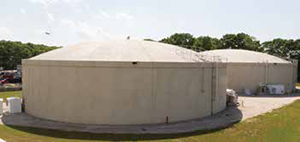 The department has historically protected tributaries that surround the airport (Tuscatucket Brook, Buckeye Brook, etc.), and the airport has taken active measures to comply accordingly with the dedicated collection of propylene glycol and ethylene glycol products.
The department has historically protected tributaries that surround the airport (Tuscatucket Brook, Buckeye Brook, etc.), and the airport has taken active measures to comply accordingly with the dedicated collection of propylene glycol and ethylene glycol products.
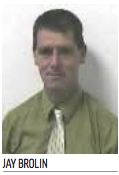 In the late 1990s, the state agency suggested deicing pads as the solution. Instead, PVD proceeded with what the airport authority considered to be a more effective active collection program that balanced aircraft operations and environmental protection. The airport's strategy included closing the valves in storm drains near the terminal and cargo operations to allow spent deicing fluid to pool in low areas so it could be collected by glycol recovery vehicles. Airport personnel affectionately referred to the labor-intensive process as the "plug it up, suck it up" method.
In the late 1990s, the state agency suggested deicing pads as the solution. Instead, PVD proceeded with what the airport authority considered to be a more effective active collection program that balanced aircraft operations and environmental protection. The airport's strategy included closing the valves in storm drains near the terminal and cargo operations to allow spent deicing fluid to pool in low areas so it could be collected by glycol recovery vehicles. Airport personnel affectionately referred to the labor-intensive process as the "plug it up, suck it up" method.
Fluids captured by the recovery vehicles were transported as far as Michigan and Indiana for recycling, and reprocessed product was sold on the secondary market as industrial antifreeze.
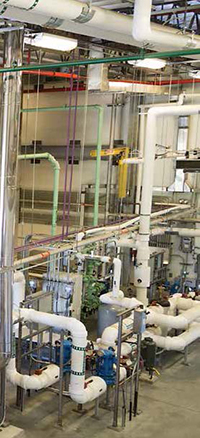 While the active collection process proved to be effective at the time, the state's environmental agency continued to encourage the installation of deicing pads as the EPA began developing Effluent Limitation Guidelines in the mid-2000s.
While the active collection process proved to be effective at the time, the state's environmental agency continued to encourage the installation of deicing pads as the EPA began developing Effluent Limitation Guidelines in the mid-2000s.
"[The Department of Environmental Management] actually wanted to get ahead of the effluent guidelines," Brolin recalls. "They wanted us to be beyond compliance, for lack of a better term."
Getting Buggy With It
The airport adopted the department's "beyond compliance" philosophy, but chose not to install deicing pads to achieve it. With the help of Gresham, Smith and Partners, PVD successfully made the case for a passive collection system mixed with a cutting-edge anaerobic digestion treatment as a superior methodology.
Total cost for the new system was nearly $26 million-$9 million for the collection system and $17 million for the treatment facility.
GS&P Executive Vice President John Lengel recalls negotiating with regulators as early as 2006 regarding permit terms for a complete system design consisting of gate collection, pumping systems, storage and treatment. Planning began in earnest in 2011. Subsequent to regulatory approval in 2012, the airport solicited bids for construction in two distinct phases, and construction commenced in July 2013. After construction was substantively completed in October 2014, the airport began collecting glycol-laden stormwater in a pair of 2.9 million-gallon aboveground storage tanks.
After the system achieved full compliance with Warwick Sewer Authority requirements in November 2015, PVD began using its carefully cultivated anaerobic bugs to treat the nearly 2.6 million gallons of fluid collected during the 2014-2015 deicing season and fall 2015.

Lengel describes the new deicing management system as optimal, because PVD can operate it with minimal to no impact on airline operations.
"(T.F. Green) can deice at the gates, and no one is the wiser as to how the runoff is being handled," he remarks. "It's working very well in that regard."
In addition, Lengel praises the system's ability to evolve with the airport. "It allows them to maintain compliance today and offers flexibility for change in the future with either a permit condition or operational change," he explains. If needed, for instance, PVD can add another onsite tank to dramatically increase its storage capacity.
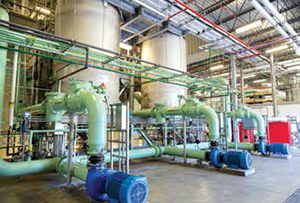 On a less tangible but critically important level, Lengel believes the completed project has also helped the community see that the Rhode Island Airport Corp. (RIAC) is committed to improving and reducing the airport's impact on the environment. RIAC is a semi-autonomous subsidiary of the Rhode Island Commerce Corp. (previously the Rhode Island Port Authority) that operates and maintains PVD and other airports throughout the state.
On a less tangible but critically important level, Lengel believes the completed project has also helped the community see that the Rhode Island Airport Corp. (RIAC) is committed to improving and reducing the airport's impact on the environment. RIAC is a semi-autonomous subsidiary of the Rhode Island Commerce Corp. (previously the Rhode Island Port Authority) that operates and maintains PVD and other airports throughout the state.
"It was a demonstration of RIAC's commitment, which was very, very important," Lengel comments. "RIAC has demonstrated that they are willing to do what it takes to protect the environment, and to do it in a manner that has minimal impact on their primary customers."
Brolin concurs, noting that the nearly $26 million system provides superior accuracy of material flow. Previous methods are now outmoded because they were more open to interpretation and subject to human error, he explains. "We now have all sorts of monitoring and meters on this system."
From a community relations standpoint, he senses more confidence among local watershed advocates that PVD is "stepping up" and doing right by the environment.
"It seems like they trust us a little more," he reflects, "and that is something you cannot buy."
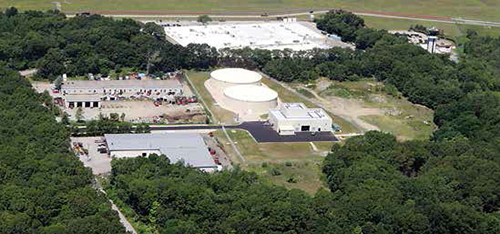
FREE Whitepaper
Fairbanks International Airport Baggage Transport Conveyor Enhanced With Mod Drive™ System
Airports face a host of unique industry challenges, such as meeting efficiency regulations and seeking out the best maintenance practices to reduce costs and keep operations flowing. In today’s current economic climate, any potential cost savings can go a long way.
In 2019, Alaska’s Fairbanks International Airport (FAI) sought to modernize its equipment and operations. They were dissatisfied with the performance of the gearmotors on their baggage transport conveyors and began searching for new suppliers. Regal approached FAI with a solution that could improve equipment performance and simplify maintenance, with the added benefit of energy cost savings: the Hub City® MOD Drive™ system.
This white paper discusses the hardware deployed, the test results and the annualized expectations for ROI.








